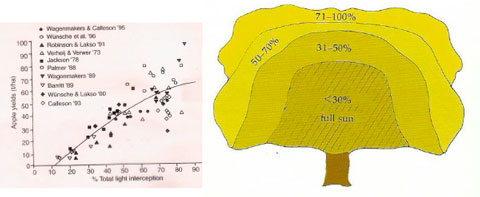Everyone knows that sunlight is important, what does it do for fruit trees?
Sunlight helps provide proper growing temperatures, but more importantly, sunlight drives the machinery that produces the building blocks to make leaves, roots, fruit and shoots.
Studies by several researchers in fruit districts around the world have shown a positive correlation between the proportion of sunlight that is captured by orchard trees and the fruit production per hectare (Figure 1).
Of the total variation in yield per hectare, about 80 per cent can be explained by the percentage captured sunlight, or ‘light interception’.
Looked at another way, just 20 per cent of the variation in yield can be explained by factors other than light interception.
The influence of sunlight on yield accounts for such a high proportion of variability in yield that you should not ignore sunlight when you manage an orchard or plan a new orchard.
Sunlight and shade
Studies have demonstrated that sunlight that strikes the orchard has a profound effect on flower bud formation, fruit set, fruit development, and fruit quality.
Through tree training and pruning, orchardists can manipulate the light environment within the canopy and affect the efficiency of the orchard.
It is easy to take sunlight for granted in planning, developing and managing an orchard. To do so is a serious mistake.
Effective use of available sunlight is critical to the success of every orchard.
For the fruit grower there is both good news and bad news about sunlight in the orchard. The good news is that sunlight, the indispensable energy source required for tree and fruit growth, is free.
Unfortunately the bad news is that:
• not enough sunlight strikes the trees in the orchard, meaning too much strikes the orchard floor, and
• not enough sunlight reaches all parts of the canopy, so too much of the canopy is severely shaded.
Zones of light
The limiting factor in the performance of a fruit tree is the shade that the tree casts upon itself.
In a large tree with a globular (umbrella) canopy, there are four zones of light (Figure 2).
A layer of fruit and foliage on the outside surface of the tree receives more light than the tree needs.
A second layer further down has adequate light, and a third layer is borderline.
A fourth layer or core in the centre of the tree has insufficient light for the production of fruit.
For greater production, the unproductive area with inadequate light within each tree must be reduced or eliminated.
The zone that receives less than 30 per cent full sunlight produces small fruit of inferior quality. Over time, the bearing wood dies in this zone forcing the bearing surface upward and outward, which encourages trees to become large.
(cont next issue)
See this article In Tree Fruit November 2022
This article is from the Orchard Manual: UNDERSTAND FRUIT TREES






















